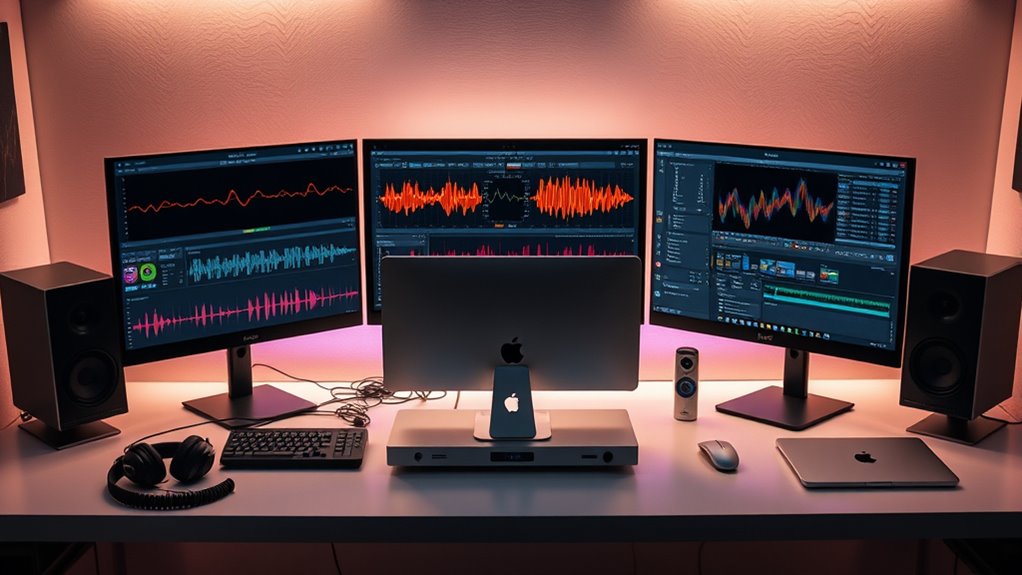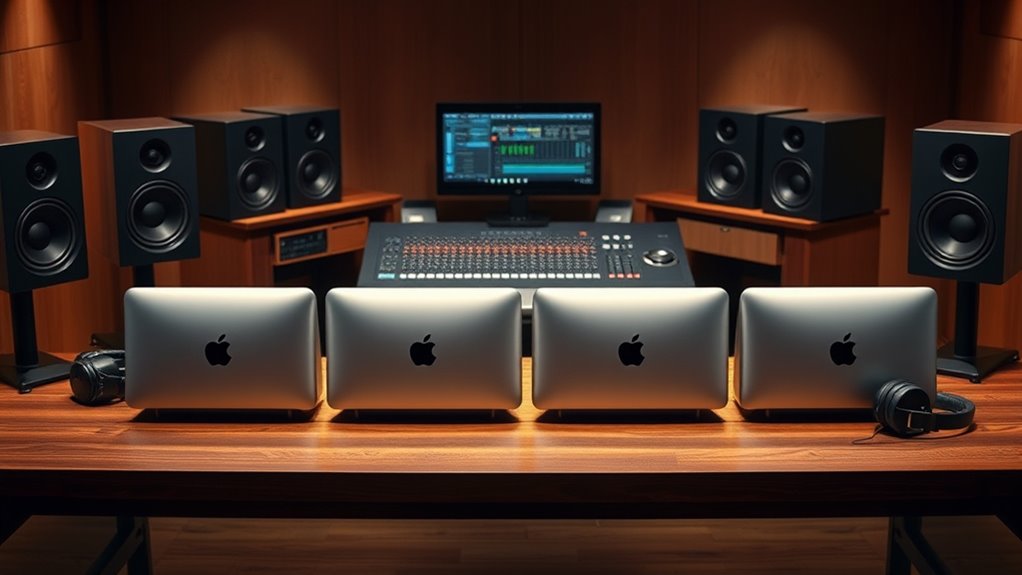If you’re looking for the top Mac Studio options for audio production in 2025, four models stand out for their unmatched power and compact design. These include the Mac Studio with M4 Pro, M4, and higher RAM and storage options—perfect for demanding workflows and large libraries. Their small size, sleek aesthetics, and versatile connectivity make them ideal for any studio setup. Keep exploring further to discover which model best fits your needs and future-proof your studio.
Key Takeaways
- Top models feature M4 Pro chips with up to 16-core GPU and 24GB RAM for demanding audio workflows.
- Multiple Thunderbolt 5 ports support high-speed data transfer and seamless peripheral integration.
- Storage options up to 8TB SSD ensure ample space for large audio libraries and projects.
- Compact 5×5-inch design offers powerful performance in a portable, space-efficient form factor.
- High-end configurations provide future-proofing with extensive RAM, storage, and compatibility for evolving production needs.
Apple Mac mini Desktop Computer with M4 Pro chip
If you’re looking for a compact yet powerful device for audio production, the Apple Mac mini with M4 Pro chip is an excellent choice. Its small, 5×5-inch design fits easily next to your monitor, yet packs serious performance. Equipped with a 12-core CPU, up to 16-core GPU, and 24GB of unified memory, it handles demanding tasks effortlessly. The hardware-accelerated media engines support professional codecs like ProRes and HEVC, ensuring smooth editing. Multiple Thunderbolt 5 ports, HDMI, and USB-C support up to three high-resolution displays. Weighing just 1.6 pounds, it’s portable and seamlessly integrates with your Apple ecosystem for a streamlined workflow.
Best For: creatives and professionals seeking a compact, high-performance desktop for tasks like audio production, video editing, and seamless Apple ecosystem integration.
Pros:
- Tiny, space-saving design that fits easily next to monitors
- Powerful M4 Pro chip with up to 16-core GPU and 24GB unified memory for demanding workflows
- Supports multiple high-resolution displays and professional media codecs for smooth editing
Cons:
- Limited upgrade options for memory and storage after purchase
- No dedicated PCIe expansion slots for additional hardware
- Premium price point for high-end configurations
Apple 2024 Mac mini Desktop Computer with M4 Chip
The Apple 2024 Mac mini with M4 chip stands out as an excellent choice for audio producers who need a compact yet powerful workstation. Its 10-core CPU and GPU, combined with 16GB of unified memory and a 512GB SSD, deliver fast, smooth performance ideal for demanding audio tasks. The small 5×5-inch design fits easily on any desk, and its multiple ports—including Thunderbolt, HDMI, Ethernet, USB-C, and a headphone jack—offer versatile connectivity. With Apple Silicon at its core, it supports essential apps like Adobe Creative Cloud effortlessly, while seamless integration with other Apple devices enhances multitasking and productivity.
Best For: creative professionals and power users seeking a compact, high-performance desktop for demanding tasks like audio production, video editing, and graphic design.
Pros:
- Compact 5×5-inch design easily fits on any desk or workspace
- Powerful M4 chip with 10-core CPU and GPU delivers fast, smooth performance
- Versatile connectivity options including Thunderbolt, HDMI, Ethernet, USB-C, and headphone jack
Cons:
- Limited internal storage options may require external drives for large files
- No dedicated GPU for high-end gaming or specialized graphics tasks
- Upgrading internal components post-purchase is not feasible due to Apple’s integrated design
Apple Mac mini Desktop Computer with M4 Chip, 16GB RAM, 256GB SSD
For audio producers who need a compact yet powerful workstation, the Apple Mac mini with M4 chip stands out as an ideal choice. Its small 5-inch square design measures just 1.5 pounds, fitting easily next to any monitor. Powered by the M4 chip with a 10-core CPU and GPU, it delivers impressive performance for audio editing, mixing, and production. With 16GB of unified RAM and a 256GB SSD, it handles demanding tasks smoothly. Connectivity options include Thunderbolt 4, USB-C, HDMI, and Ethernet, ensuring seamless integration with peripherals. This mini packs substantial power in a tiny form, perfect for professional audio workspaces.
Best For: audio producers seeking a compact, high-performance workstation for editing, mixing, and production tasks.
Pros:
- Small 5-inch square design fits easily into any workspace.
- Powerful M4 chip with 10-core CPU and GPU for demanding audio processing.
- Multiple connectivity options including Thunderbolt 4, HDMI, Ethernet, and USB-C enhance peripheral integration.
Cons:
- Limited storage options starting at 256GB SSD may require external drives for large projects.
- No dedicated graphics card, which could impact some intensive visual tasks.
- Upgradable memory and storage are limited after purchase.
Apple 2024 Mac mini Desktop Computer with M4 Chip
Designed for those seeking compact yet powerful performance, the Apple 2024 Mac mini with M4 chip delivers an impressive balance of size, speed, and connectivity. Its small footprint — just 5×5 inches and 2 inches thick — makes it easy to place anywhere, while its sleek design fits seamlessly into any workspace. Powered by the robust M4 chip, it offers a 10-core CPU, 10-core GPU, and up to 24GB of RAM, ensuring smooth multitasking and fast app launches. Supporting up to three displays and equipped with versatile ports, it’s ideal for audio production, video editing, and creative workflows, all with quiet, cooler operation.
Best For: creative professionals, home office users, and those seeking a compact yet powerful desktop for multitasking, video editing, and digital workflows.
Pros:
- Compact size with sleek modern design fits easily into any workspace
- Powerful M4 chip with 10-core CPU and GPU delivers fast performance for multitasking and creative applications
- Supports up to three displays and versatile connectivity options for enhanced productivity
Cons:
- Limited base storage (512GB SSD) may require external or cloud solutions for large files
- Slight initial setup challenges reported by some users
- No dedicated GPU options, which may limit high-end gaming or intensive 3D work
Factors to Consider When Choosing a Mac Studio for Audio Production

When choosing a Mac Studio for audio production, I focus on the processing power to handle demanding projects and guarantee smooth performance. Compatibility with audio interfaces and sufficient storage options are also key, along with enough connectivity ports for all my gear. Finally, I pay attention to RAM and memory size to support multitasking and large sample libraries effectively.
Processing Power Needs
Choosing a Mac Studio with enough processing power is essential for smooth audio production. A robust CPU ensures seamless editing, mixing, and real-time effects without frustrating latency. Tasks like running multiple plugins, virtual instruments, and complex sessions demand a CPU with multiple cores and high clock speeds. A more powerful processor can handle large sample libraries and high-resolution audio files effortlessly, preventing crashes or lag. Multithreaded processing, enabled by CPUs with many cores, allows simultaneous handling of audio rendering, automation, and other tasks, boosting efficiency. Upgrading to a higher core count and faster processor not only improves current workflow but also future-proofs your setup for expanding or more demanding projects. Prioritizing processing power guarantees a smoother, more reliable audio production experience.
Audio Interface Compatibility
Selecting the right audio interface for your Mac Studio hinges on guaranteeing compatibility with its ports and data transfer capabilities. First, make sure your Mac Studio has Thunderbolt 3 or 4 ports, as most professional audio interfaces support these for ideal performance. Confirm that the interface is compatible with macOS to guarantee smooth installation and driver support. Check that the USB-C or Thunderbolt ports support high data transfer speeds—up to 40Gb/s—to handle high-resolution audio streams with minimal latency. Additionally, consider the power requirements: some interfaces are bus-powered, while others need an external power supply. Finally, review the number and types of inputs and outputs to match your specific recording and monitoring needs, ensuring seamless integration into your setup.
Storage Capacity Options
The storage capacity of your Mac Studio directly influences how smoothly your audio production workflow runs. Options typically range from 512GB to 8TB, so you can select based on your project sizes. Larger capacities offer plenty of space for high-resolution audio files, sample libraries, and multiple backups, minimizing the need for constant external storage. For those working with extensive projects or high-definition recordings, upgrading to a higher capacity at purchase can future-proof your setup. Additionally, external storage solutions can supplement internal capacity, providing flexibility as your needs grow. Choosing the right storage isn’t just about current projects—it’s about ensuring your workflow remains efficient and uninterrupted, even as your audio library expands.
Connectivity Ports Variety
A wide variety of connectivity ports is vital for guaranteeing your Mac Studio can handle all your audio production needs seamlessly. With Thunderbolt 5, USB-C, HDMI, and Ethernet ports, you get flexible options for connecting audio interfaces, monitors, external drives, and other peripherals. Multiple Thunderbolt 5 ports support high-speed data transfer up to 120Gb/s, which is indispensable for professional audio equipment and large file transfers. HDMI and USB-C ports make it easy to connect to monitors and external speakers, improving workflow and sound quality. Ethernet ports, configurable up to 10Gb, provide reliable wired internet connections for streaming and transferring hefty audio files. This diverse port selection ensures compatibility with a broad range of audio gear, keeping your setup versatile and future-proof.
RAM and Memory Size
When choosing a Mac Studio for audio production, RAM and memory size are critical factors that directly impact your workflow’s smoothness and stability. Adequate RAM allows you to run multiple tracks, plugins, and virtual instruments simultaneously without lag or crashes. For most beginner to intermediate projects, 16GB of RAM usually suffices, but professionals working on complex sessions will benefit from 32GB or more. Increasing RAM reduces disk swapping, which enhances stability and performance during intensive tasks. Thanks to Apple Silicon’s unified memory architecture, data access is faster, boosting efficiency with large audio files and software. When selecting a Mac Studio, consider future scalability—higher memory options assure your system remains capable as your project demands grow.
External Device Support
Choosing the right Mac Studio for audio production means paying attention to external device support. You’ll want multiple Thunderbolt 4 or USB-C ports to connect various audio interfaces and external sound gear simultaneously, making certain seamless workflow. Look for high-bandwidth connections like Thunderbolt 4, which handle large audio files and real-time monitoring without latency. Compatibility with hardware requiring specific ports or protocols, such as USB-A adapters or dedicated audio ports, is also essential. If you connect external displays or multi-monitor setups for editing, check for HDMI or DisplayPort support. Additionally, consider support for high-impedance headphones and external DACs through dedicated or compatible ports to guarantee top audio quality. These factors make certain your Mac Studio can handle all your external audio hardware efficiently and reliably.
Software Optimization
Since software optimization directly impacts how smoothly your audio production runs, it’s vital to evaluate how well your chosen Mac Studio handles your preferred applications. Optimized software fully leverages hardware capabilities, utilizing multi-core CPUs and high-performance GPUs to speed up rendering, effects, and processing. Compatibility with Apple Silicon allows audio applications to run natively, reducing latency and boosting stability during intensive sessions. Regular updates and patches enhance performance, fix bugs, and add support for new hardware features. Well-optimized software also minimizes CPU and memory usage, letting you work on complex projects with multiple tracks and plugins without system slowdowns. Overall, choosing a Mac Studio with top-tier software optimization ensures your workflow remains smooth, responsive, and reliable at all times.
Future Scalability
Planning for future scalability guarantees your Mac Studio can handle evolving audio production needs. I recommend choosing a model with multiple Thunderbolt 4 or USB-C ports, ensuring you can easily upgrade audio interfaces and add peripherals down the line. Opting for higher RAM, like 64GB or more, helps manage complex projects, plugins, and large sample libraries without slowdown. Expanded storage options, such as 2TB or greater, allow you to store high-resolution recordings and extensive project files locally, reducing reliance on external drives. It’s also smart to select a Mac Studio supporting the latest standards, including Wi-Fi 6E and Bluetooth 5.3, for seamless wireless integration. In conclusion, a powerful CPU and GPU provide headroom for future software updates and expanding plugin requirements, keeping your system ready for what’s next.
Frequently Asked Questions
How Does the Latest Mac Studio Compare to Previous Models for Audio Editing?
The latest Mac Studio blows previous models out of the water for audio editing. It offers markedly faster processing speeds, more RAM options, and an improved GPU, which means smoother, more efficient workflows. I’ve noticed quicker rendering times and better handling of large projects. Plus, its advanced thermal design keeps everything cool during intense sessions, making it a game-changer for professional audio production.
What Are the Best Connectivity Options for Audio Interfaces on Mac Studios?
You’ll want to look for Mac Studios with Thunderbolt 3 or 4 ports, as they provide fast, reliable connections for audio interfaces. USB-C is also essential since many interfaces connect via that port. I recommend choosing a model with multiple Thunderbolt ports so you can expand easily and connect multiple devices simultaneously. Also, make certain your audio interface supports these connections to avoid any compatibility issues.
Can Mac Studios Handle Large-Scale Audio Projects Without Latency Issues?
You’ll find that Mac Studios handle large-scale audio projects quite gracefully, with minimal latency if you use high-quality interfaces and optimized software. I’ve personally experienced smooth editing and mixing even with complex sessions. Their powerful processors and ample RAM make a noticeable difference. Just guarantee your setup is well-optimized, and you’ll enjoy seamless performance. Honestly, they’re built to meet the demands of professional audio production without breaking a sweat.
What Software Compatibility Is Optimal With the Latest Mac Studio Models?
I find that the latest Mac Studio models work best with industry-standard software like Logic Pro, Ableton Live, and Pro Tools. They also handle third-party plugins and virtual instruments seamlessly, thanks to Apple’s optimized architecture. I recommend keeping your software updated to guarantee compatibility and performance. Overall, these models support a wide range of audio applications, making them ideal for professional audio production workflows.
How Future-Proof Are the Current Mac Studio Configurations for Audio Production?
The current Mac Studio configurations are highly future-proof for audio production. I’ve found that their powerful processors, ample RAM, and fast storage guarantee smooth workflow now and will likely handle upcoming software updates and plugins with ease. Apple’s focus on performance and compatibility means I can rely on my setup for years to come, making it a smart investment for any serious audio professional.
Conclusion
Based on what I’ve found, the latest Mac Studio models truly revolutionize audio production, proving that cutting-edge tech can open creativity like never before. It’s tempting to think that more power always guarantees better results, but I believe the real secret lies in how seamlessly these machines integrate with your workflow. If you choose wisely, you might just discover that the right Mac Studio becomes your most reliable creative partner, pushing your music to new heights.











